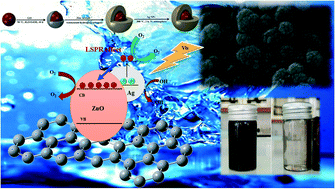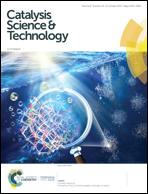Novel magnetic Fe3O4@rGO@ZnO onion-like microspheres decorated with Ag nanoparticles for the efficient photocatalytic oxidation of metformin: toxicity evaluation and insights into the mechanisms†
Abstract
Emerging water contaminants, including pharmaceutical and personal care products, have become a major concern in water pollution, and several efforts have been made for the efficient removal of these contaminants. To address this concern, this study reports the synthesis of a new nanostructured hybrid onion-like spherical catalyst, Fe3O4@rGO@ZnO/Ag-NPs (FGZAg), and investigates its ability to degrade metformin (MTF) under both ultraviolet- and visible-light irradiation. The catalysts were prepared using functionalized Fe3O4 microspheres as the templates, successively coated with graphene oxide and ZnO shells followed by Ag nanoparticle (NP) decoration, which were finally annealed under a N2 atmosphere. The prepared samples were characterized using XRD, N2 adsorption–desorption, SEM, HRTEM, UV–vis absorption spectroscopy, FTIR spectroscopy, Raman spectroscopy, VSM, XPS, EIS, and PL measurements. The results showed that the prepared onion-like spheres with a hexagonal wurtzite crystal structure had a mesoporous texture, and Ag NPs were loaded on the surface of the catalyst. As compared to plain ZnO, the as-made FGZAg catalyst significantly enhanced the photocatalytic activity toward MTF degradation under visible-light irradiation. The complete degradation and 60% mineralization of 20 mg L−1 MTF was achieved with FGZAg within 60 min in the visible-light photocatalytic process. The interaction between rGO and Ag NPs exhibited a beneficial synergistic effect and reduced electron–hole recombination, thereby facilitating charge transport. The possible mechanism for MTF degradation was the generation of ˙OH and ˙O2− radicals. Furthermore, the magnetic characteristic of the prepared catalyst facilitated its separation from the treated solution. The as-prepared magnetic FGZAg catalyst could preserve its catalytic activity during four consecutive cycles of the MTF degradation process. The cytotoxicity of the untreated and photocatalytic oxidation (PCO)-treated MTF solutions was evaluated using cultured human embryonic kidney (HEK) cells, which revealed that the MTF solution in the developed PCO system could be significantly detoxified.



 Please wait while we load your content...
Please wait while we load your content...